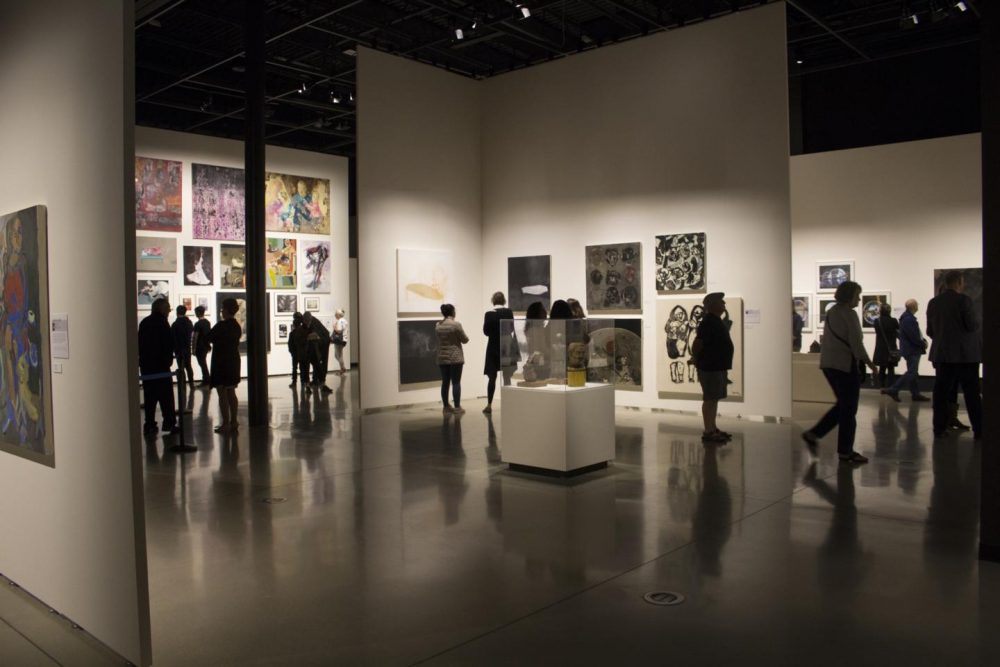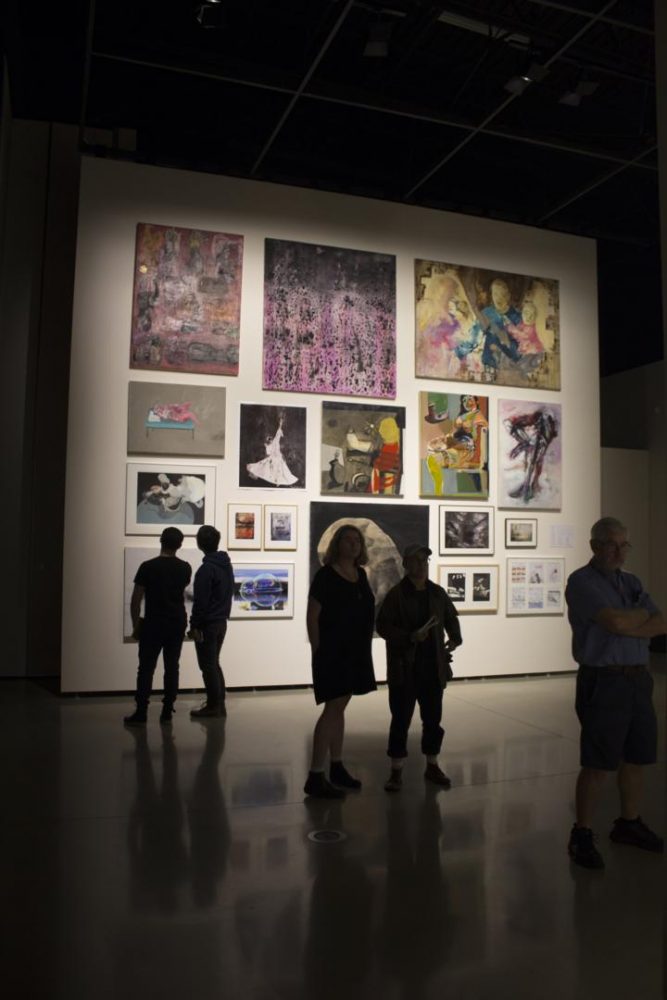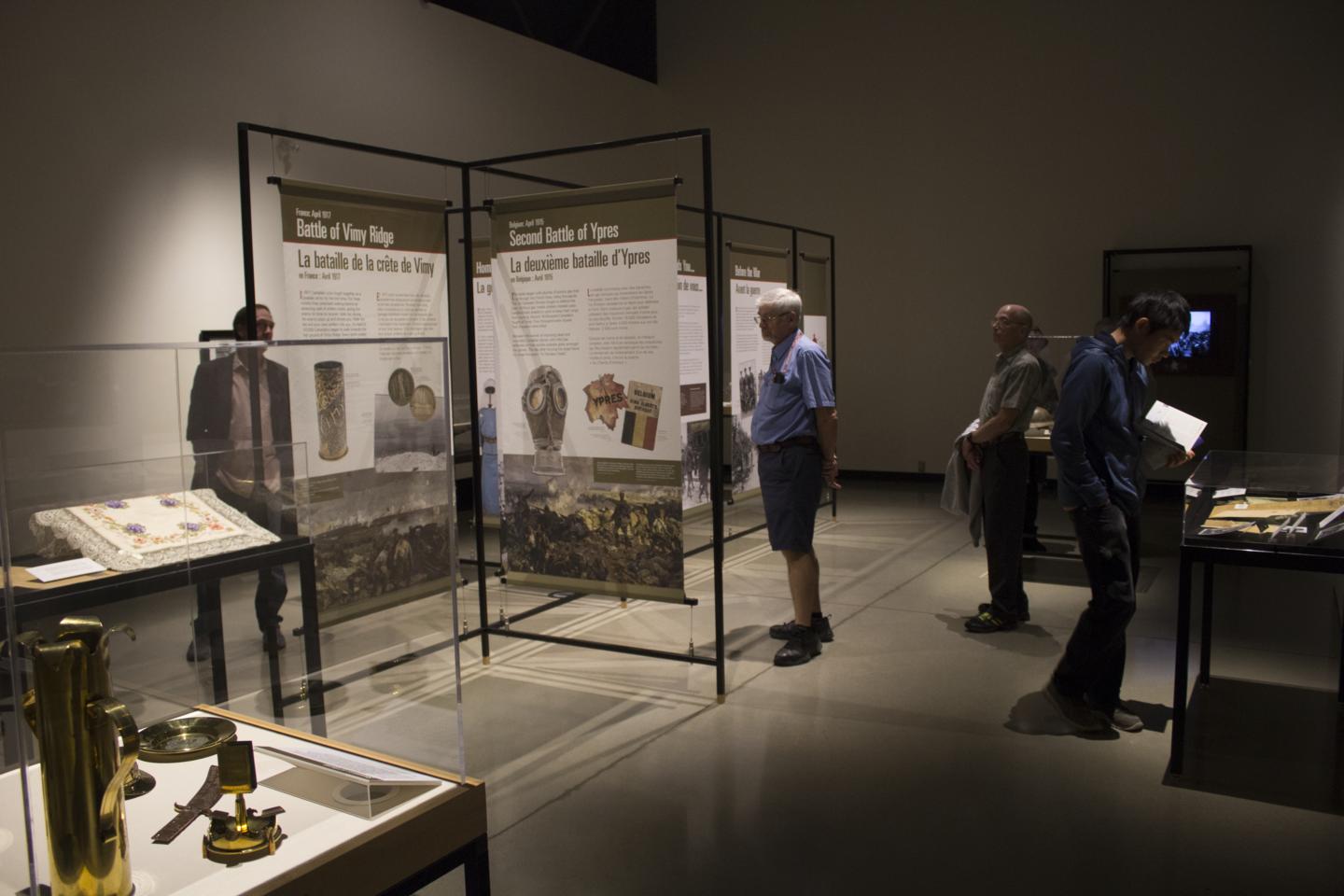The arts and culture community in the Fraser Valley has continuously demonstrated its capacity for diversity. The latest set of exhibitions at The Reach Gallery Museum in Abbotsford serve to strengthen that fact, and also to bring our global community closer together. On Thursday, Sept. 27, The Reach held its grand opening reception for its fall/winter exhibitions. These include British Columbia’s War, 1914 – 1918, Ambivalence Boulevard by Dick Averns, and Behind the Lines: Contemporary Syrian Art.
Behind the Lines is a collection of work by 20 Syrian contemporary artists. The exhibition was co-curated by Paul Crawford from the Penticton Art Gallery, and is in partnership with the Cyrrus Gallery in Damascus. The Penticton Art Gallery has been responsible for the formulation, organization, and touring of the exhibition, which has already visited many locations across B.C.
Crawford began working on making this exhibition a reality in 2015. His goal was to try and reach out to artists and citizens from countries currently affected by war to speak on their own behalf about what is truly going on there. He eventually happened upon an online gallery space on Facebook, which served to preserve the culture of Syria, and to provide an outlet for artists from the University of Damascus. At that point, there was no one buying art in Syria at the time, and there were no gallery exhibitions to be had.
During his speech, Crawford explained his negotiation process with the gallery, which lasted over a period of six months through Facebook messaging. The most challenging hurdle in getting the exhibition off the ground, both figuratively and literally, was shipping, as there hadn’t been any shipping in Syria for a long while. In the end, they managed to wire $5,000 to Beirut, where the individual who ran the online gallery would go to pick it up and negotiate with a black-market shipping company to ship the work here to Canada.

At the beginning of the tour of this exhibition, 13 of the artists were still living in Syria. Since then, approximately six have been able to leave the country and find refuge elsewhere. A few still remain in Damascus, where they are still struggling to make ends meet.
In a closing statement about this exhibition’s journey, Crawford said: “One of the most beautiful things about this show was, throughout it all, I learned that as much as we may have very different upbringings and histories, we are more alike than we are different. One of the things about the show which I think is very important, is not only the artwork, but the people behind it.”
A delightful treat which was provided to attendees in the gallery’s foyer, were platters of authentic Syrian cuisine. The cuisine was made possible by the Abbotsford Community Foundation, and Tayybeh, a food company that supports female Syrian chefs who are newcomers to Canada.
Three other exhibitions opened that evening as well, including work by British-born, Calgary-based artist Dick Averns who served in the Canadian Forces artist program in 2009. The program has been a valuable tool in documenting war and conflict zones and has been running in some format since the First World War. Works in this collection were created by Averns while he was stationed in Egypt, near the border of Gaza, Israel. In the grotto gallery space at the front of the museum, Averns’ film Ambivalence Boulevard is currently being screened. This work considers the role of politics and power in more peaceful locales that are no less implicated in the complexities of global conflict.
British Columbia’s War is an exhibition that has been developed and circulated by the Royal B.C. Museum in Victoria. Its purpose is to explore our province’s role in the First World War, and considers the horrors of the battlefield, 100 years after the fact. Kris Foulds, The Reach’s curator of historical collections, selected artifacts and documents from The Reach’s collection to accompany the artifacts on loan, and to provide context for the impact of the war here in Abbotsford. The Abbotsford Legion Branch #15 has been generous enough to sponsor a portion of the costs for this travelling exhibition.
 Art on Demand 4.3 also opened this evening. This ongoing initiative is part of the Reach’s Emerge program, which supports aspiring artists and arts professionals in the Fraser Valley. Curated by Kate Petrusa, the works by artist Sarah Wright are a mixed-media project that’s an exploration of how urban spaces are socially constructed, and which maps the experiences of those who are excluded from the systems of power that are established in our cities and towns.
Art on Demand 4.3 also opened this evening. This ongoing initiative is part of the Reach’s Emerge program, which supports aspiring artists and arts professionals in the Fraser Valley. Curated by Kate Petrusa, the works by artist Sarah Wright are a mixed-media project that’s an exploration of how urban spaces are socially constructed, and which maps the experiences of those who are excluded from the systems of power that are established in our cities and towns.
At the beginning of the evening’s opening statements, Mayor Henry Braun announced that the Reach is officially celebrating its 10th anniversary this month. He gave thanks to The Reach in a brief statement: “The Reach brings our community together, facilitates dialogue, broadens our understanding of the world, compels us to be inspired by the creative spirit, and supports artists in our local community.”
As part of the 10th anniversary celebrations, a unique fundraising campaign in support of the museum’s historical collections, “100 Days of The Reach,” will give local individuals the opportunity to select and sponsor an artifact for one year. The cost of sponsoring an object is $100, which will go towards preserving, researching, and digitizing the treasures currently held in their collections. Inquiries about sponsorship can be answered at their front desk.
Schneider also announced that for the first 50 artifacts that are sponsored, the funds will be matched by Marg and Roy Warkentin. Up until recently, the couple were The Reach’s neighbours, having previously owned the Esso station across the street. The station first opened in 1956 as a gas station and coffee shop, and after a few years of economic change, the self-serve station as it stands today was erected in 1976.
An Arabic-English translation was also provided for those in attendance, which covered most of the remarks of the evening. A catalogue for this exhibition is also available with translated Arabic text for $15 at the gallery’s reception desk.
The event concluded with Schneider inviting the public to attend a more in-depth tour of the exhibition. The Reach will be offering free tours hosted by curator of art & visual culture Adrienne Fast on Oct. 6 and 13. The tours will be offered in both English and Arabic. These exhibitions will be on display at The Reach until Jan. 6, 2019.
Images: Cassie de Jong/The Cascade


